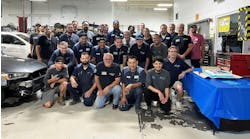Completing a profitable repair is a complex puzzle that may leave your hard-earned profits in your customers bank account. Many repairs begin with a Diagnostic Service. Getting paid for diagnostic services can be a daunting task. Let’s face it — most consumers think we should have an app or computer that tells us exactly what is wrong with the car. When a customer brings a vehicle to a repair shop, they are contracting with the shop to find the root cause of the client concern and successfully repair these concerns. Anything less than a successful repair is viewed as failure and some customers will go so far to say the shop “ripped them off.” Properly repairing vehicles is a complex task that even the best shops struggle with. Not to mention the Diagnostic Service is the most expensive labor operation the shop can perform. In order to be successful and create the income you deserve, there are 3 keys to getting paid for your diagnostic services, they are:
- Build profitable diagnostic packages and charge a fair price for them.
- Prepare an awesome sales presentation that removes the fear from the transaction.
- Create a diagnostic and repair process that eliminates comebacks and fixes the car right the first time.
Key #1: Build profitable diagnostic packages and charge a fair price for them
The most critical part of profitability for an automotive repair shop is collecting money for every segment of time utilized on every vehicle, every day, at the proper rate. Automotive repair shops generate revenue from two main sources; parts and labor. When a technician is performing a diagnostic test, that labor operation is not providing parts revenue. This fact is what makes the diagnostic service the most expensive labor operation the shop can perform. To recover the lost revenue from testing it is important to charge a higher labor rate for these services. Variable labor rates have been used in the auto repair industry for years and help shops create the profits they deserve. A fair markup on your labor rate is typically 25% - 50% of your baseline rate. Remember we are trying to recover the lost gross profit on the part sales, not 100 percent of the parts sale
Let’s look at an example:
Notice in our illustration, the shop has a baseline labor rate of $100 per hour. To recapture the lost profit of the missing part gross profit from this labor operation we are marking up our labor rate 25 percent or adding $25 to the rate. In addition, our Level 1 package is going to include an additional resource fee to recover the fees associated with accessing information and updating our diagnostic tools. These fees are typically not figured into the baseline labor rate of most shops. Through extensive research we have found a $12.51 fee is a reasonable addition to the package to recover the amount of money spent to provide these services.
Our new package price is going to charge $137.51 instead of $100 for a Level 1 testing package. Setting this up in your shop management system is as simple as building a canned job and setting the labor rate at the new rate. You can add the fee in separately or just build it into your new rate.
Notice the additional annual revenue collected of $32,821.25. This money can go a long way to providing new tools, training, benefits, and even a higher paycheck for a diagnostic technician. There is no set rule when creating your pricing. Your shop is unique and has many special talents and should be compensated accordingly. If you need help creating your pricing model please send me an email to [email protected] and I will be happy to help you master this critical pricing puzzle for your shop. This is for a basic diagnostic package that typically can be completed in 1 hour. For those tough diagnostic packages, we move into our advanced testing package, which we will cover in a future article. Now that we know what to charge, let’s take a look at how to make the presentation.
Key #2: Prepare an awesome sales presentation that removes the fear from the transaction.
The Sales Presentation is where the customer decides if they will pay your fees or not. This is where you have to shine! The first step to selling Diagnostic Packages is to really believe in your process. The diagnostic and repair process are designed to help the customer get their concern resolved in the least amount of time and it also ensures that the shop follows a logical step by step process to save the customer time and money. Let’s look at an example of the verbiage you might consider when selling Diagnostic Packages.
Mr. / Mrs. _______ based on your concern there are a number of things that can cause the concern you’ve described. So right now what we have are more questions than answers. In order to resolve your concern, we need to begin with our Level 1 Testing Package. Here’s the checklist that my technician Tim will be using today. This process is designed to help you get this concern resolved in the least amount of time and it also ensures that we follow a logical step by step process to ensure we save you time and money. When he’s finished with this test I’ll get his report and we’ll be able to review the results together. You have my word that I’ll do everything within my power to save you money and get this car back on the road in the most efficient way. The fee for our Level 1 Test is $137.51 and I just need your signature here and I’ll get Tim started on it right away.
If the customer objects to the testing fee and asks, “You mean you’re going to charge me just to look at it?” you could reply with the following:
We would be wasting a lot of your time, and your money, if we went ahead and did any service that we thought might solve your problem. So rather than guessing, we like to take the guesswork out of it completely. We need to complete a Root Cause Analysis to find out what failed and more importantly why it failed.
Our testing more than pays for itself when you consider the amount of time, and money that would be wasted if we tried to take shortcuts or guess as to what the problem could be. I’d rather be up front and honest with you about having to charge for professional testing fees, again you have my promise that our team will do everything we can to fix your car in the most affordable way. Again I just need your signature on the estimate so we can begin.
Key #3: Create a diagnostic and repair process that eliminates comebacks and fixes the car right the first time.
Let’s face it, nobody wins when a vehicle is not properly repaired. A comeback or misdiagnosis is one of the costliest transactions for a shop. Creating a system that provides valuable information for your client as well as ensuring you are taking the necessary steps to eliminate comebacks and misdiagnosis will help you maximize profits. A good repair process on a vehicle incorporates several items. These all lead to a proper diagnosis and a successful repair, ultimately saving both the shop and client time and money. What should be in your repair process?
- Proper write-up. Ensure the customers concern has been properly documented.
- Baseline test. This includes a basic visual inspection of the basic systems on the vehicle. Including fluid levels and condition, wiring, connectors, vacuum hoses, air intake boots, oil leaks, evidence of rodent damage etc.
- Complete scan of the onboard computer system.
- Research ECM updates, TSB’s, SIB’s and Recalls.
- Confirmation of client concern.
- Pinpoint or Isolation testing of suspected failed components that factually verifies cause of failure.
- Confirmation of resolution of client concern.
Using a system outlined above provides the client with valuable information about their vehicle. This not only ensures a proper repair, but it justifies the diagnostic charges the customer should pay. If you provide the right customer deliverable in the form of a checklist, pdf printout of the scan report, and any factory level testing plans the customer begins to understand the complexity of the testing process and their resistance will melt away.



